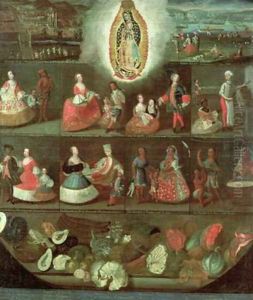Luis de Mena Paintings
Luis de Mena was a Mexican painter who is best known for his contribution to the development of Mexican art during the colonial period. Born around 1709, de Mena was active during a time when Mexico was a flourishing viceroyalty under Spanish colonial rule. The exact details of his early life and training are not extensively documented, but it is known that he was based in Mexico City and became a prominent artist there.
De Mena's work is characterized by religious subjects, as was common for artists of his time due to the strong influence of the Catholic Church in colonial Mexico. He is particularly recognized for his skillful integration of European artistic techniques with indigenous elements, creating a unique visual language that reflected the hybrid culture of colonial Mexico.
One of his most famous works is the 'Castas' painting, which depicts the complex system of racial classification that existed in colonial Mexico. The 'Castas' series was a set of paintings that illustrated the racial mixing between Africans, Europeans, and indigenous people, resulting in a highly stratified society. De Mena's painting is a significant historical document that provides insights into the social structure and racial dynamics of the time.
In addition to his paintings, Luis de Mena was also known for his work in other mediums, including murals and altarpieces, which adorned many religious buildings in Mexico. His art is an important part of Mexico's colonial heritage, and his contributions to Mexican art history are still studied and appreciated today.
Although the exact details of his death are unclear, Luis de Mena is believed to have died around 1780. His legacy lives on in the rich tradition of Mexican art, and his works are held in various collections, including museums in Mexico and abroad, attesting to his enduring influence on the cultural landscape of Mexico.
